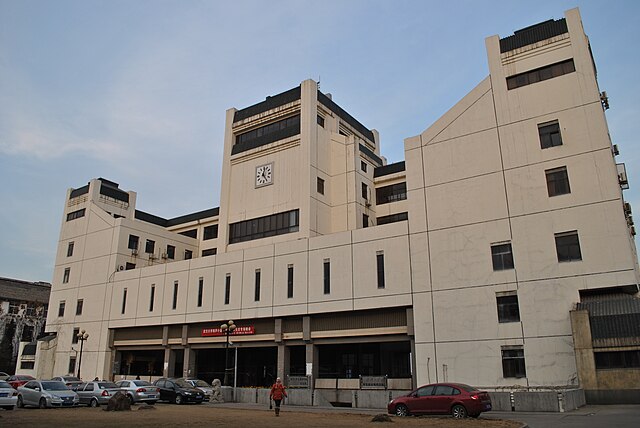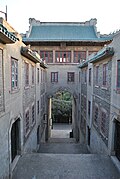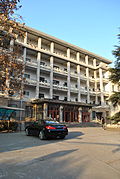Wuhan University
Public university in Wuhan, Hubei, China From Wikipedia, the free encyclopedia
Wuhan University (WHU; 武汉大学) is a key comprehensive public university in Wuhan, Hubei, China. It is directly affiliated with and funded by the Ministry of Education of China. The university is part of Project 985, Project 211, and a pioneer in the Double First-Class Construction initiative.[3]
武汉大学 | |||||||
 | |||||||
| Motto | 自强 弘毅 求是 拓新[1] | ||||||
|---|---|---|---|---|---|---|---|
Motto in English | Self-improvement, Perseverance, Truth-seeking, Innovation[2] | ||||||
| Type | Public | ||||||
| Established | Incorporated as a university in 1926 | ||||||
| President | Zhang Pingwen | ||||||
Academic staff | 7,325 | ||||||
| Students | 58,720 | ||||||
| Location | , , China | ||||||
| Campus | Urban, 3.5 km2 | ||||||
| Website | en | ||||||
 | |||||||
| Chinese name | |||||||
| Simplified Chinese | 武汉大学 | ||||||
| Traditional Chinese | 武漢大學 | ||||||
| |||||||
History
Summarize
Perspective
The university's origins trace back to 1893 with the establishment of Ziqiang Institute by Zhang Zhidong, the then governor of Hubei and Hunan provinces during the late Qing Dynasty (1644-1911).[3]
In 1926, National Wuchang University, National Wuchang University of Commerce, Hubei Provincial Medical University, Hubei Provincial University of Legislation, Hubei Provincial University of Liberal Arts, and the private Wuchang Zhonghua University were merged into National Wuchang Sun Yat-sen University (also known as National Second Sun Yat-sen University). The school has an undergraduate department and 6 subjects including liberal arts, science, law, economics, medicine, and preparatory courses, 17 departments, and 2 institutes.[4][5][6][7]
In 1928, the Nanjing National Government officially established the National Wuhan University based on the former National Wuchang Sun Yat-sen University, with four colleges: liberal arts, law, science, and engineering.[4][5][6][7]

In 1949, National Wuhan University was taken over by the Communist Party and renamed Wuhan University.[4][5]


Academics
Summarize
Perspective
In 2024, Wuhan University's student body consisted of 29,488 full-time undergraduates and 24126 full-time master's degree candidates, 3007 international students and 3940 faculty staff.[8]
Wuhan University has strong teaching strength. As for the opening of disciplines, in 2024, Wuhan University offers 130 undergraduate majors, covering 13 disciplines such as philosophy, economics, law, education, literature, history, science, engineering, agriculture, medicine, management, art, and cross-disciplines. There are also 58 master's degree-level disciplines and 53 doctoral degree-level disciplines. As for the faculty, there are 12 academicians of the Chinese Academy of Sciences, 6 academicians of the Chinese Academy of Engineering, 3 academicians of the Eurasian Academy of Sciences, 12 senior professors of humanities and social sciences, and 15 national teaching masters.[9]
Wuhan University also has strong scientific research strength. In 2024, the university has a number of scientific research bases and centers, including 4 national key laboratories, 2 national engineering technology research centers, 2 national field scientific observation research stations, 8 key laboratories of the Ministry of Education, 6 engineering research centers of the Ministry of Education, etc. The university publishes 32 professional journals openly on a regular basis.[9]
Reputation and rankings
| BCUR National[10] | Domestic | 9 | |
|---|---|---|---|
| Wu Shulian National[11] | Domestic | 6 | |
| CUAA National[12] | Alumni | 10 | |
| QS National[13] | General | 8 | |
| THE National[14] | General | 8 | |
| QS Asia (Asia version)[15] | General | 38 | |
| THE Asia (Asia version)[16] | General | =30 | |
| ARWU World[17] | Research | 89 | |
| QS World[18] | General | 194 | |
| THE World[19] | General | =134 | |
| USNWR World[20] | General | 108 | |
Wuhan University is ranked in the top 200th global universities by major international universities rankings, including the Academic Ranking of World Universities, the QS World University Rankings, the Times Higher Education World University Rankings, the Center for World University Rankings, and the U.S. News & World Report.[21][22][23][24][25]
From 2024 to 2025, U.S. News & World Report ranked it 108th in the world, 21st in Asia and 11th in China.[26]
In 2024, Academic Ranking of World Universities ranked it 89th in the world, 15th in Asia and 9th in China.[27]
In 2025, Times Higher Education World University Rankings ranked it 134th in the world 8th in China.[28]
In 2025, QS World University Rankings ranked it 194th in the world, 38th in Asia and 15th in Greater China (Including Mainland China, Hong Kong, Macau and Taiwan).[29]
Research
Regarding scientific research output, the Nature Index 2023 ranked Wuhan University the No.14 university in the Asia Pacific region, and 33rd in the world among the global universities.[30] The 2023 CWTS Leiden Ranking ranked Wuhan University 22nd in the world by total publications and 45th in the world based on the number of their scientific publications belonging to the top 1% in their fields for the time period 2018–2021.[31]






Campus
Summarize
Perspective
Basic Overview
Wuhan University boasts a campus covering an area of 5508 mu and has a floor area of 2.42 square kilometres. The university has rolling physical features with the scenic Luojia Hill and the beautiful East Lake. Its campus is heavily wooded and green, with fragrant flowers everywhere year-round. Wuhan University is widely known as one of the most beautiful universities in China, especially for its cherry blossom garden. A cherry blossom festival is held every spring.[9][32]
Early Buildings
The early buildings of Wuhan University are located between more than ten rolling hills such as Lujia Mountain and Lion Mountain on the shore of East Lake in Wuhan City, Hubei Province. The complex is characterized by the integration of traditional Chinese architectural concepts with Western architectural techniques and classical architectural art; in terms of architectural monolithic modeling, it is due to the mountainous terrain, different forms, exquisite layout and grandeur. The early buildings of Wuhan University are the only university campus buildings in modern China with complete planning and coordinated design and completed in a relatively short period of time, which is the largest and most beautiful group of modern university buildings in China, and can be regarded as the masterpieces and models of modern university campus buildings in China.[33]


Most stylish old buildings were designed by F. H. Kales (1899–1979).[34] Educated in MIT, Kales was a pioneer to blend western architectural styles with traditional Chinese elements, which is most evident from his roof designs.[citation needed]
Wuhan University boasts a campus covering an area of 5508 mu and has a floor area of 2.42 square kilometres. The university's libraries have a collection of approximately 5.4 million volumes and subscriptions to more than 10,000 Chinese and foreign periodicals.[35]
Libraries
Wuhan University Library has a long history and a rich collection of books, which was officially established in 1917 and named as the National Wuhan University Library in 1928. the old library building was opened in 1935, and in October 2011, the new Wuhan University Library (Main Library) with a total floor area of 35,548 square meters was inaugurated, and the service function of the library was further improved.[36]
As of the end of 2023, the library's collection comprised 22.82 million items, including 7.32 million print materials: 6.04 million books, 880,000 bound periodicals, 180,000 maps, audiovisual and microfilm materials, and 220,000 theses. In the same year, the library subscribed to 572 databases, granting access to 15.5 million digital resources, including 13.02 million e-books and 2.48 million e-journals.[36]
Cherry Blossoms
In 1939, during the Second Sino-Japanese War, the Japanese army planted the first batch of cherry trees in Wuhan University (WHU), to relieve the homesickness of their troops. These trees were preserved after the war ended, despite their historical links.[37]
Later, in 1972, to mark the normalisation of China-Japan relations, another batch of cherry trees was offered to Premier Zhou Enlai, who gave 20 trees to WHU. The WHU website describes subsequent donations in 1983 by biology professor Wang Mingquan, who studied in Kyoto, and by a Japanese delegation in 1992.[37]
Every year in late March, a large number of cherry blossoms bloom on campus, attracting countless tourists into the school to watch, become a scene in Wuhan.
- Luojia Hill (Luojiashan)
- Former School of Science
- Administration Building, Former School of Engineering
- Former Dorm for male students
- Wuhan's blue roof tiles
- 2nd Classroom Building
- 3rd Classroom Building
- Former Law School Building
- Student Club
- Student Union and Debate Team
Campus Culture
Summarize
Perspective
Interpretation of Motto
In order to carry down and develop glorious tradition and fine university spirit, encourage constantly refreshed spirit, hard studying, rigorous scholarship, innovation, and forging ahead of faculty, staff and students, the new motto of Wuhan University was developed. It was based on the opinions from all university levels and the examination of university administration committee in 1993:
Self-improvement, broad and strong minded, truth seeking, and innovation.[38]
In general, the overall significance of our motto is to carry down and develop Chinese nation's great spirit of ceaseless self-improvement, establish great ambition of studying hard and dedication for our thriving and prosperous country, with tenacious characters and scientific and rigorous attitude, explore objective law of development of things strenuously, initiate new prospects, obtain new achievements, run the Wuhan University of socialism well, and continue to make new contributions to our country.[38]
The University Gate
The earliest memorial gateway is located inside the opening of the street. It was built about in 1937. The new memorial gateway was built according to the old one before its centennial in 1993 using the funding raised by Shenzhen Alumni Association and alumni at home and abroad. On its back is "art, law, science, engineering, agriculture, and medicine" six characters, representing six colleges, and on its front is "National Wuhan University". Many people are interested in who wrote the memorial gateway of "National Wuhan University". However, this issue is still in controversy. At present, the statement that majority of people agreed is that, "National Wuhan University" on the new memorial gateway at front gate of Wuhan University were inscribed by Mr. Cao Lian, and "art, law, science, engineering, agriculture, and medicine" on the back of memorial gateway were written by professor Liu Boping.[38]
Campus Activities
At Wuhan University, there are a variety of activities for students to participate in.
Luojia Golden Autumn Art Festival
Luojia Art Festival in Golden Autumn was established in 1987, which is the most famous brand in campus cultural activities of Wuhan University. The festival is aimed to sing the main rhythm of the times, and to fuse art competition and art appreciation perfectly.[38]
"Spring of the Luojia" Cultural Festival of Science and Technology
With the main body of college students' science and technology festival, academic lectures and science and technology competitions, such as extracurricular academic works of science and technology contests, business plan competitions, "Luojia Forum", "Red Maple Forum", "Academician Forum", "Innovation and "Entrepreneurship Forum", "Life Planning and Occupation Navigation" etc., are held regularly, to nurture and enhance science and technology innovation ability, entrepreneurial ability, and employment competitive power.[38]
"Economy and Management Forum of Luojia young Scholar"
Since the forum was instituted ,dozens of academic activities have been held successfully, which greatly strengthened academic exchanges and enriched the research field. The forum uses papers as main content, and commenting by critics and free-spoken as main form, aiming to promote collision of minds and stimulate enthusiasm of scientific research. The speakers are young scholars from universities, mainly PhD. students. The contents of the forum are extensive, and usually are the latest research results of the speaker, which reflects the academic frontier in related area, and are beneficial for improving their own ability. The specific time and place of the forum are not fixed. It is usually held on a weekly basis. For specific schedule, please pay attention to college's posters, and field of scientific research and foreign affairs on the college's home page. The paper for each lecture can be downloaded from website.[38]
Cooperation
Wuhan University has established cooperative relationship with more than 300[citation needed] universities and research institutes in over 40[citation needed] countries and regions.
- School of Information Management at Wuhan University signed a cooperation agreement with Royal School of Library and Information Science in Denmark in 2009.[39][40]
- Wuhan University has collaborated with Duke University and the city of Kunshan to establish Duke Kunshan University.[41][42]
Notable alumni
Summarize
Perspective
As of 2017 at least 29 billionaires had graduated from Wuhan University, ranking third place in the South Central China region and 9th nationally.[43]
- Li Zhongchu, billionaire businessman
- Govornor RIAK BIM, Govornor of Unity State, South Sudan
- Guo Moruo, Chinese author, poet, historian, archaeologist, and government official from Sichuan, China
- Bin Jiang, professor, in GIS at Högskolan i Gävle (HIG)
- Chen Tanqiu, Chinese revolutionary, founding member of the Chinese Communist Party
- Shen Congwen, Chinese writer
- Wen Yiduo, Chinese poet and scholar
- Li Long Lam, archaeologist
- Li Siguang, founder of geomechanics
- Li Zhongchu, billionaire businessman
- Ling Shuhua, Chinese modernist writer whose short stories became popular during the 1920s and 30s
- Wan Exiang, professor of international law at Wuhan University, vice president of the Supreme People's Court of China, and vice president of the Revolutionary Committee of the Kuomintang
- Wang Yanyi, Chinese immunologist and current Director General of the Wuhan Institute of Virology
- Su Xuelin, Chinese author and scholar
- Xiaokai Yang, Chinese-Australian economist
- Wang Tieya, eminent Chinese jurist and former judge of the International Criminal Tribunal for the former Yugoslavia
- Li Haopei, Chinese jurist, diplomat and academic
- Chao Yao-dong, Taiwanese politician, economist and former Minister of Economic Affairs (1981–84)
- Wu Mi, one of the founders of Chinese comparative literature
- Chi Li, contemporary Chinese writer
- Zheng Lihui, Chinese gymnast, was part of the Chinese team that won the gold medal in the team event at the 2000 Summer Olympics
- Xiao Hailiang, Chinese diver who became an Olympic champion in the 3m Springboard Synchronized event at the 2000 Summer Olympics
- Li Da, Chinese marxist philosopher
- Karim Massimov, Prime Minister of Kazakhstan (2007–2012)
- Lei Jun, founder of Xiaomi Tech, one of China's largest technology companies
- Liu Jingnan, GPS engineer, member of Chinese Academy of Engineering, former president of Wuhan University
- Xiaolin Wu, computer engineer[44][45][46]
- Yi Zhongtian, writer, historian and professor at Xiamen University
- Tiare Aguilera Hey, Rapa Nui politician
- Wang Zhi'an, journalist and former China Central Television television host
- Chiao-Min Chu, engineer and a fellow member of the Institute of Electrical and Electronics Engineers
In 2025, the Hurun Global Rich List showed that Xiaomi CEO Lei Jun was one of the fastest-growing entrepreneurs this year, with his wealth reaching 220 billion yuan, entering the top 10 in China for the first time.[47]
References
External links
Wikiwand - on
Seamless Wikipedia browsing. On steroids.










